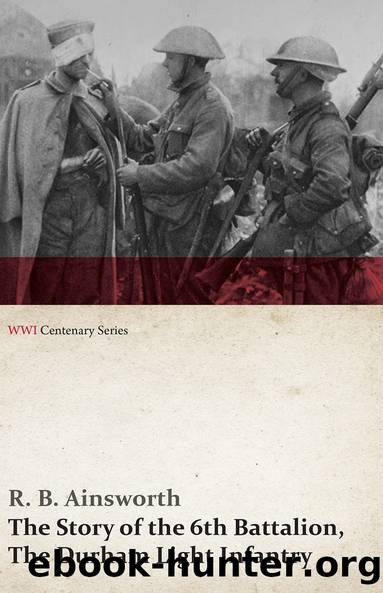The Story of the 6th Battalion, The Durham Light Infantry (WWI Centenary Series) by R. B. Ainsworth

Author:R. B. Ainsworth [Ainsworth, R. B.]
Language: eng
Format: epub
Tags: History, Military, World War I, Europe, Great Britain, General, Western
ISBN: 9781473368446
Google: 6ymRDwAAQBAJ
Publisher: Read Books Ltd
Published: 2016-03-10T00:42:46+00:00
CHAPTER IV.
Arras.
First Phase.
From Morcourt the Battalion moved by motor âbuses through Amiens to Talmas preparatory to a long trek on foot. The first two nights were spent at Wargnies and Havernas. Here a famous Church Parade was held, at which the Commanding Officer, in the absence of a Chaplain, preached his first and, as it proved, his last sermon. From there the Battalion marched to Longuevillette and then to Vacquerie-le-Bourcq, spending a night at each place. About this time Lieut. Arnott left the Battalion and Lieut. G.D.R. Dobson (7th Durham Light Infantry) became Adjutant. The next day Blangerval and Blangermont were reached and a short stay made, half the Battalion being accommodated in each village. From here Major Hunt went up by car to see the forward area and died of heart failure on the journey. He was brought back to St. Pol, where he was buried in the cemetery, representatives of several battalions forming the funeral procession. Major A. Ebsworth, M.C., took over command.
When the march was resumed the direction was changed, and, moving eastwards, billets were reached at Neuville-au-Cornet. Rumours were now spreading of the forthcoming battle and a further march to Villers-sur-Simon left no doubt that the Battalion would be involved. These were the last billets occupied by the men, the next portion of the trek bringing them to huts at Montenescourt, about six miles due west of Arras. Here Lieut.-Col. F.W. Robson, D.S.O. (5th Yorkshire Regiment) arrived to take over the command, which he held for nearly a year.
On the evening of the 11th April, in a blinding snowstorm, the Battalion moved forward to the fight. Marching through Arras, they came to the caves at Ronville. These caves were like nothing seen before. Excavated by Spanish prisoners in the middle ages to provide stone for the building of the city, they extended over an enormous area, and were capable of holding thousands of men. The sensation of finding oneself in this huge underground town, complete with electric light and water supply, after stumbling down a long, uneven stairway, will not be forgotten by those who survive.
After one night here, the caves had to be evacuated next morning to make room for more troops coming up. The Germans had now been driven back as far as Wancourt, which was captured the previous day. On leaving the caves, cellars in Ronville village were occupied. No sooner were the men in, however, than orders were received to move further forward. The Battalion paraded on the road leading to Beaurains, which was crowded with vehicles and men, and marched off in the afternoon. After their experiences of trench warfare the sight of open, rolling country, the scene of yesterdayâs fighting, was very strange and, to some, invigorating. Passing through the ruins of Beaurains and Neuville Vitasse, the route turned across country towards Wancourt, and about dusk the Battalion reached a sunken road, where it halted. Owing to a delay in the arrival of the Lewis gun limbers, the Lewis gunners
Download
This site does not store any files on its server. We only index and link to content provided by other sites. Please contact the content providers to delete copyright contents if any and email us, we'll remove relevant links or contents immediately.
| African American | Asian American |
| Classics | Anthologies |
| Drama | Hispanic |
| Humor | Native American |
| Poetry | Southern |
Crazy Rich Asians by Kevin Kwan(9105)
How to Bang a Billionaire by Alexis Hall(8022)
Giovanni's Room by James Baldwin(7096)
Little Fires Everywhere by Celeste Ng(7043)
Win Bigly by Scott Adams(7022)
Tease (Temptation Series Book 4) by Ella Frank(5547)
Pachinko by Min Jin Lee(5502)
The Fire Next Time by James Baldwin(5185)
The Perks of Being a Wallflower by Stephen Chbosky(4514)
China Rich Girlfriend by Kwan Kevin(4441)
Bluets by Maggie Nelson(4420)
First Position by Melissa Brayden(4365)
The Sympathizer by Viet Thanh Nguyen(4249)
Rich People Problems by Kevin Kwan(4211)
A Little Life (2015) by Hanya Yanagihara(4123)
Right Here, Right Now by Georgia Beers(4051)
Walking by Henry David Thoreau(3844)
Catherine Anderson - Comanche 03 by Indigo Blue(3524)
I'll Catch You by Farrah Rochon(3485)
